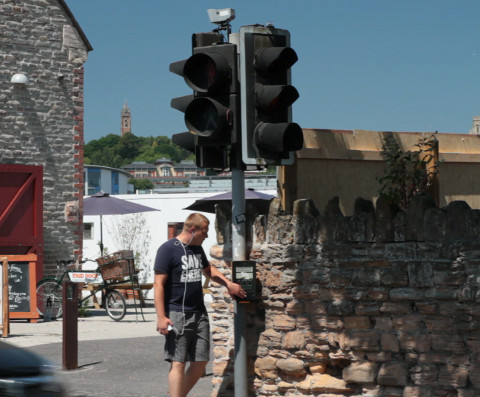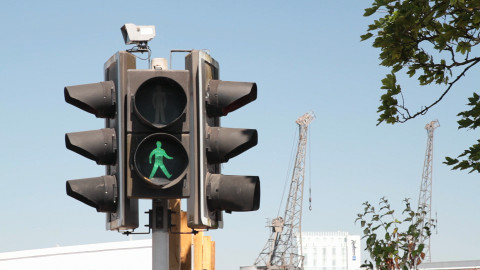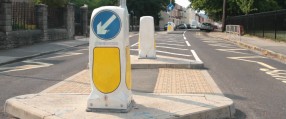Pelican Crossing

Pelican crossings are no longer installed in Bristol, so this page is for reference only.
Pelican Crossings use traffic lights to stop vehicles, allowing pedestrians to cross. Pedestrians push a button at the side of the road, and wait for a signal to cross - this is from a standing red man to a walking green man. The pedestrian signal is located on the opposite side of the road. The kerbs are dropped at both ends of the crossing, usually with tactile paving where the pavement slopes towards the road.
Pelican crossings are an older crossing design compared to Puffin crossings. Pelican crossings do not extend the crossing time for slower crossing pedestrians, instead there is flashing green man / flashing amber stage which allows slower pedestrian to finish crossing, or vehicles to start moving if the crossing is clear. There are no sensors to cancel pedestrian demand, or to extend the standard pedestrian crossing time.
Disadvantages
- Less safe than Puffin crossings
- Vehicle users may make pedestrians feel uncomfortable by creeping forwards
- Pedestrians must wait for the signal before crossing. It may take considerably less time to cross at a Zebra crossing
- Pedestrians may walk into the road when the signal changes without checking the traffic has come to a complete stop
- Pelican crossings may be less attractive than other crossing types, which are less obtrusive in smaller streets with narrow pavements

Advantages
- Pedestrians given a clear signal when to cross
- Vehicle drivers given clear signal when to stop for pedestrians
- Pedestrians never have to wait too long to cross
- Pedestrian crossing signal visible to all pedestrians across the road
- Can help maintain the flow of vehicle traffic in busy pedestrian areas when a Zebra crossing would cause traffic delays
- Motor vehicle compliance with traffic lights is very high

Effectiveness
Usability
Compared to a puffin crossing, pedestrians may feel less comfortable using a Pelican crossing. This is due to the flashing green man / flashing amber phase, where motor vehicles may harass pedestrians by creeping forward into the crossing area, even if pedestrians are still crossing.
Safety
Pelican crossings are less safe than Puffin crossings. For safety effects of conversion from Pelican to Puffin crossings, see the section on Puffin crossings
Restrictions
Pelican Crossings are no longer installed in Bristol.
- Pelican crossings can't be installed within 20 meters of a junction or roundabout
- Must be installed where the traffic light signals are visible to approaching vehicles
- The beeping sound heard at Puffin crossings may cause a noise problem for any nearby houses.
Advanced information
Statements relating to pedestrian comfort and perception of harassment from motor vehicle drivers is highlighted by research for TfL (Outlook Research, 2005), which compared pedestrian views of Pelican and Puffin crossings.
References
Outlook Research (2005) Puffin and Pelican Crossings: views of pedestrian users. Report for Transport for London.








